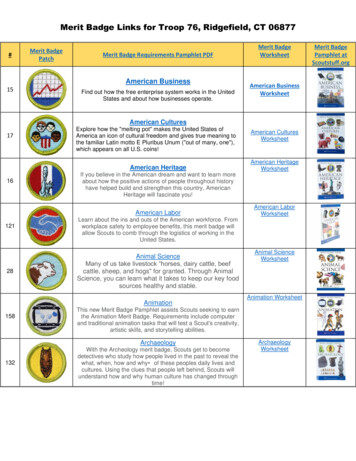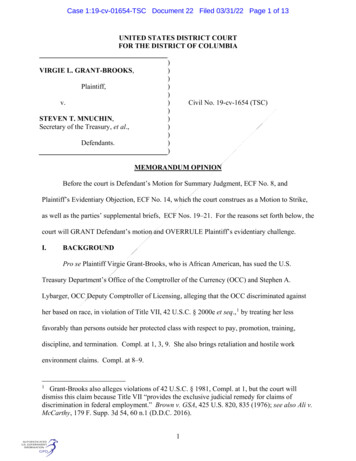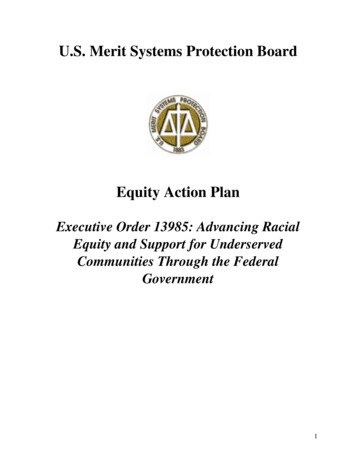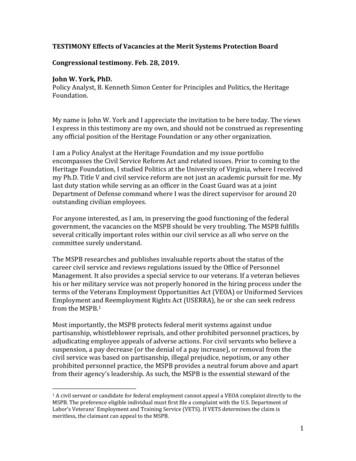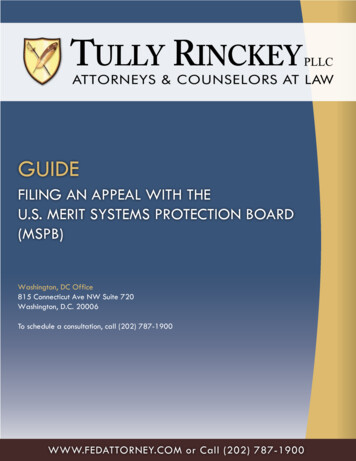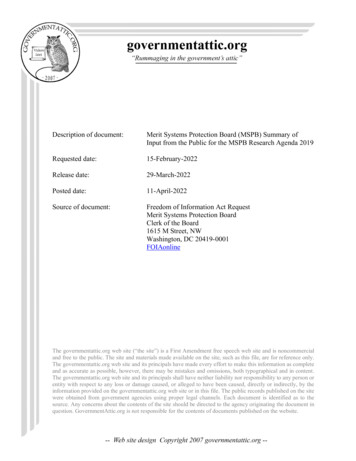
Transcription
Description of document:Merit Systems Protection Board (MSPB) Summary ofInput from the Public for the MSPB Research Agenda 2019Requested date:15-February-2022Release date:29-March-2022Posted date:11-April-2022Source of document:Freedom of Information Act RequestMerit Systems Protection BoardClerk of the Board1615 M Street, NWWashington, DC 20419-0001FOIAonlineThe governmentattic.org web site (“the site”) is a First Amendment free speech web site and is noncommercialand free to the public. The site and materials made available on the site, such as this file, are for reference only.The governmentattic.org web site and its principals have made every effort to make this information as completeand as accurate as possible, however, there may be mistakes and omissions, both typographical and in content.The governmentattic.org web site and its principals shall have neither liability nor responsibility to any person orentity with respect to any loss or damage caused, or alleged to have been caused, directly or indirectly, by theinformation provided on the governmentattic.org web site or in this file. The public records published on the sitewere obtained from government agencies using proper legal channels. Each document is identified as to thesource. Any concerns about the contents of the site should be directed to the agency originating the document inquestion. GovernmentAttic.org is not responsible for the contents of documents published on the website.
U.S. MERIT SYSTEMS PROTECTION BOARDOffice of the Clerk of the Board1615 M Street, N.W.Washington, D.C. 20419-0002Phone: 202-653-7200; Fax: 202-653-7130; Email: foiahq(@msob. aovMarch 29, 2022SENT VIA EMAILRE:Final Response for Request MSPB-2022-000090This is the final response to your Freedom of Information Act (FOIA) request to the U.S.Merit Systems Protection Board (MSPB) dated and received February 15, 2022. In your request,you sought the following:A copy of each document (such as an Excel file or Word document) listing and/orsummarizing suggestions received from the public for the MSPB Research Agenda. Youmay limit this request to records during the most recent Research Agenda cycle, between2019 and present. However, if no such records exist, then I instead request the listing ofapproximately 400 suggestions received from the public during the previous ResearchAgenda cycle.We have conducted a comprehensive search of the departments most likely to have recordsresponsive to your request. After a careful review, we have determined that portions of thefollowing record have been withheld pursuant to FOIA Exemption 5 and Exemption 6. See 5U.S.C. §§ 552(b)(5), (b)(6). The record, originally contained in an Excel spreadsheet, has beenconverted to a PDF so that the withholdings mentioned above could be applied to the record. 2019 Research Agenda public input.FOIA Exemption 5 exempts from disclosure those inter-agency or intra-agency recordsthat are normally privileged in the civil discovery context. The three most frequentlyinvoked privileges are the deliberative process privilege, the attorney work-productprivilege, and the attorney-client privilege. After carefully reviewing the responsivedocuments, we determined that the responsive documents qualify for protection under thefollowing privilege:
Deliberative Process PrivilegeThe deliberative process privilege protects the integrity of the deliberative ordecision-making processes within the agency by exempting from mandatorydisclosure opinions, conclusions, and recommendations included within interagency or intra-agency memoranda or letters. The release of this internalinformation would discourage the expression of candid opinions and inhibit the freeand frank exchange of information among agency personnel. The agency hasdetermined that there is foreseeable harm in releasing the withheld informationbecause the latest research agenda remains in draft form pending a final agencydecision.Therefore, the withheld information would deprive departmentemployees and incoming Board members of having open and frank discussionregarding some aspects of the proposed topics.FOIA Exemption 6 exempts from disclosure personnel or medical files and similar filesthe release of which would cause a clearly unwarranted invasion of personal privacy. Thisrequires a balancing of the public's right to disclosure against the individual's right toprivacy. The privacy interests of the individuals in the records you have requestedoutweigh any minimal public interest in disclosure of the information. Any private interestyou may have in that information does not factor into the aforementioned balancing test.The agency has determined that there is foreseeable harm in releasing the withheldinformation because it would be an invasion of the individuals' privacy.If you wish to contact the FOIA Public Liaison, you may do so via email tofoiahq@mspb.gov or telephone at (202) 254-4475. If you wish to participate in dispute resolutionservices, you may contact the Office of Government Information Services (OGIS). The contactinformation for OGIS is as follows:Office of Government Information ServiceNational Archives and Records Administration8601 Adelphi Road-OGISCollege Park, Maryland 20740-6001E-mail at ogis@nara.govTelephone at 202-741-5570Toll free at 1-877-684-6448Facsimile at 202-741-5769If you wish to appeal the determination, you may do so by submitting your appeal throughFOIAonline or by mailing your appeal to:Chairman, c/o Clerk of the BoardU.S. Merit Systems Protection Board1615 M Street, NWSuite 500Washington, DC 20419
Your appeal should be identified as a "FOIA Appeal" on both the letter and the envelope,if applicable. It should include a copy of your original request, a copy of this letter and yourreasons for appealing this decision.You may also submit your appeal by email tofoiahq@mspb.gov or by fax at (202) 653-7130. Your appeal must be filed within ninety (90) daysfrom the date of this letter.Sincerely,//signed//Karin KellyGovernment Information SpecialistU.S. Merit Systems Protection Board
Public InputTo what extent is time‐in‐grade a barrier to career advancement, how much should it be one, and whatinequities are there in allowing some situations to bypass time in grade (excepted service) while others are heldback by these rules? (Suggestion from FMA.)Does HR really understand all the hiring authorities well enough to apply them properly and take advantage ofthem? Should we reduce the number of authorities so that HR can understand them and managers can trustthat HR knows what it is doing? (Suggestion by FMA)Change policies and laws to emulate the more successful and profitable private sector employment models.Focus on those with high satisfaction amongst employees.Because of the blend of employees and contingent workers (contractors, consultants, etc) would be good tounderstand how to better build and manage a blended team.Require certain position series/grade levels to take Government 101. And the study ti see if the agencies wherethese topics are taught annually have been performance. Teach them federal agency law from Appropriationslaw, FOIA, PRA, FITARA, Travel, etc.Potential effect of absorbing OPM into GSA (with security checks handled by DOE) on hiring and retirementSecurity clearances. Position descriptions not meeting the required criteria to designate as requiring a securityclearance. Agencies are using this as a retaliatory tool. AJs are not trained in this area but are making decisionswithout the required expertise.
The use of technology in Federal recruitment and hiring is always a hot topic when discussing improvements inacquiring talent. Federal agencies are recruiting at a disadvantage to the private sector in that the majority areforced to use USAJOBS to post jobs and accept applications. Add to the mix that the majority of agencies also useUSA Staffing and it becomes evident that the speed of innovation is at the speed of OPM's Human ResourcesSolutions. Private sector organizations utilize enterprise Applicant Tracking Systems (ATS) that enable themanagement of career websites, job postings, the hiring process, online assessments, social media accounts, andother online marketing capabilities while supplying real‐time analytics on applicant flow, diversity, recruitingactivities, social media effectiveness, and talent pipeline management. The USAJOBS/USA Staffing combinationseverely restricts agencies in their ability to effectively engage and source talent in a way that can provide apositive candidate experience while monitoring analytics and applicant flow in real‐time. The current onlinerecruitment and hiring process has not improved since the most recent hiring reform effort a decade ago as isevidenced by this recent article ��until‐its‐time‐apply/157049/. USAJOBS/USA Staffing is the problem and not the solution. TheFederal Government can hire a diverse, qualified workforce in a tight economy if its set free to utilize the besttechnology available.Selection rates for minorities in the hiring process needs to researched. For example, based on current OPMdata, Hispanics apply, qualify, and are referred to the hiring manager at rate corresponding with theirrepresentation in the work force. When it comes to selections from the certificate of eligibles, Hispanicrepresentation is in the single digits. The fact that this has been true for over ten years is critical tounderstanding that bias exists in the selection process.The under‐utilization of the Pathways Programs for Students and Recent Graduates needs to be reviewed. Thenumber of hires under the Programs in 2018 was just under 4,000 out of a workforce of over 2 million. Whyaren't agencies hiring more students and recent graduates? What does agency workforce planning tell themabout the future of their workforce?One of the challenges is the perception that Executive Leadership is poor as reflected in the FedView results.Only 1 of every 2 employees have a high level of respect for organizational senior leaders and see them asgenerating high levels of motivation and commitment in the workforce, maintaining high standards of honestyand integrity, and providing satisfactory the information on what’s going on in the organization. Given that thisis an average, in a significant number of agencies and their subcomponents, much less than half the employeesdo not perceive their senior leaders as effective. What is going on in those lower half agencies andsubcomponents that there is little faith, trust, and confidence in their leaders?Look into the time, staff, and steps needed to take disciplinary or performance based action in practice (asopposed to "letter of the law"). Due process isn't and shouldn't be free, but no one seems to know what it takesto do it right. (See article at provided link.) A clearer view could be useful to both policymakers andpractitioners. www.fedsmith.com/2019/05/14/show‐me‐money‐2/
Reform of the GS classification system to allow consolidation of series into categories instead of 400 individualseries. There is no good reason in 2019 to distinguish between occupations in the same job family (e.g., GS‐0301versus GS‐0343). Let agencies put jobs into broader categories, most of which would fall into the “1 yr ofspecialized experience” qualifications criterion, and let agencies define what specialized experience means. Evenwith the dwindling classification workforce, there is way too much still required by OPM, and almost none of it istruly necessary per Title V law.It would be good to look at current talent management practices that I believe are hamstrung by fears of MSPB.If we want to do well by our missions we need to be able to have honest conversations where we differentiatepeople on the basis of performance and potential and then develop and promote them accordingly. How can wedo this in a similar fashion to private industry and not be derailed by MSPB?Are state merit systems going away?How well are we balancing merit‐‐hiring, promoting, and rewarding based on ability‐‐with using the sameprocesses to achieve some desired degree of representation in the workforce of particular demographic groups?Is there a "deep state" influence in Federal human capital policies and practices?Does the Administrative Law Judge program office really belong at OPM or GSA? What about placing itsomewhere more consistent with the independent nature of that occupation?Are each of the protected groups given equal consideration and protection? If not, why not?What changes can be made to the way the Federal workforce is funded that would allow all or most of it tocontinue working when there is a protracted dispute over yearly appropriations? These shutdowns cost money,impair effective action, and are too often used as political footballs. Let's take the ability to do that away fromthe politicians while preserving their proper role of deciding how to allocate funds.Use of Personal Cell Phone While on Duty at Work Because so many supervisors do not circulate physically infederal government offices, many employees appear to abuse their freedom to make personal calls and to texton their personal cell phones while on duty at work. How many estimated work hours are spent on personalphones of employees who are making personal calls and texting? What is the estimated cost of this loss ofproductivity at work and how can organizations and supervisors make it harder for employees to continue thisabuse? What policies could be implemented to help curb this activity?
I would request MSPB study the cost/benefits (utility) of a pro bono‐like service for a determination of standingregarding violations of merit system principles that can be utilized by every Federal employee or job applicant(not just the subset who are either former military or whistleblowers ‐ a separate study should look into howmany Federal employees are truly eligible for MSPB .htm]). In other words, a quick, low‐cost option to review allegedviolations of Prohibited Personnel Practices [https://www.mspb.gov/ppp/ppp.htm] to determine if there isstanding and if there is non‐binding, but sufficient belief that a Prohibited Personnel Practice has been infringedwithout filing a full claim.I suggest that OPE study the impact on the ability of parties to reach settlements in light of the E.O. whichessentially bans clean record settlements. In 2013 OPE issued a study on clean record settlements and the law.In light of the new E.O., this may be a good time to take a new look at settlement agreements.It would be interesting to know what effect the DVA's new disciplinary authority under 38 U.S.C. 714 is having onthe implementation of the merit system principles within that agency.How prevalent is age discrimination and nepotism in promotions? Young people are promoted over employeeswith more experience. Also, although family members are not in the same chain of command, there is influenceif a family member is in a higher position. There have been interviews for a position by the spouse of the personthat was selected.Does pay banding actually work when it’s not funded right and how it impacts teamwork when everyone it outfor themselves?Are lengthy suspensions an effective management tool? For instance, is there any evidence that a 30‐daysuspension is any more effective than a 5‐day suspension in correcting misbehavior? Might lengthy suspensionsbe counterproductive to the extent that they entail disengagement from the agency's mission for an extendedperiod of time or exacerbate personal problems that may have contributed to the underlying misconduct in thefirst place (e.g. financial trouble, stress at home)?Sufficiency of currently utilized performance standards? Do current standards accurately measure performance?Are they an accurate measure of the actual position and assigned duties?Proper use of probationary period: Should agency’s be required (by regulation or otherwise) to demonstrate anew/probationary employee was provided with a certain level of training and/or instruction before determiningto separate the individual?
Merit Principal 3 states, “Equal pay should be provided for work of equal value, with appropriate considerationof both national and local rates paid by employers in the private sector, and appropriate incentives andrecognition should be provided for excellence in performance.” The core Human Resources function that appliesthis principal to the Federal Workforce is the Position Classification System. However, as demonstrated byinternal watchdog reports for decades now, Federal Managers have sought to undermine this process since itsinception. GAO’s “Quality of Government‐wide Classification and Position Management Practices” published onApril 26th, 1978 could have been written in 2019. My suggestion to begin to address this issue is simple. Everyyear OPM publishes Federal employment data which identified the average GRADE DISTRIBUTION of FederalAgency Headquarters staff, e.g. what percentage of that workforce is GS‐15, GS‐14, etc. I propose all agenciesHQ staffs be “benchmarked” against that average, and be given a scorecard gauging each agencies deviationfrom that base‐line, i.e. demonstrate with CLEAR DATA which agencies are outlandishly top‐heavy in their gradecomposition. These scorecards can then be shared amongst MSPB, OPM, various congressional oversightcommittees with jurisdiction of specific agencies and the Federal workforce in general, etc. It would provide asimple “canary in the coal mine” for oversight entities to identify instances of probable Agency mismanagementregarding how they execute their Classification and Position Management delegated authorities. Egregiousmismanagement of such systems constitute a gross misallocation of appropriated funds, a violation of the publictrust, a clear barrier to fair competition in hiring top talent between Federal Agencies, and a blatant disregard forMerit Principal 3.The Rooney Rule has had great successes in the private sector making the workforce more diverse, efficient, andeffective. Research into the legal and workforce implications of a Rooney Rule for the federal governmentpromises to make government a better and more effective place to work.Foster an inclusive and equitable work environment and organizational cultureHow to address "unusual" behavior . Managers struggle with articulating why behaviors that are not obviouslymisconduct are disruptive and they often have great difficulty in addressing it before it becomes a crisis.Some appointed positions, such as the MSPB members, should be allowed to stay in office until theirreplacement is confirmed or allow the roll to be filled temporarily.The talent acquisition field in the private sector has gone through a tectonic shift; most private sector companiesare "sourcing," which means that good candidates never even hit the market. They're lured away from one jobto another. There are some obvious issues with sourcing in the federal government. But it would be really, reallyhelpful if MSPB could do a study to define ways that we might participate in this modern hiring style using linkedin, social media, and yes, even sourcing, without running afoul of merit principles.
Investigate MSPB "Administrative Judges'" notorious pro‐management bias and unprofessional, unethicalconduct. How much more Congressional testimony is needed before you act? Discipline and remove "AJs" whoroutinely abuse their discretion with unethical or incompetent initial decisions. (b) (5), (b) (6)I would be interested in learning the average cost of MSPB appeals for both employees and agencies. Similarcosts for grievances and (especially) EEO complaints would be of even greater interest.AWOL: Right now, there are MSPB decisions on the books that have overturned AWOL‐related removals for asmuch as 12% of an employee's available duty time (which, for a full FTEE, can be as much as 192 hours). Thereneeds to be clear guidance to the agencies as to how much AWOL is too much.The impact of Sec. 5, EO 13839 on settlement rates, the willingness of the agencies to take adverse actions, andthe cost of litigation.The Acting EEOC Chair's report on agency's anti‐harassment policy requirements seems to create tension withthe MSPB guidance and rules enforcing merit system principles and disciplinary actions. The report andsubsequent audit activities directs agencies to take action on harassment complaints for conduct that does notrise to the level of prohibited discrimination, including mandatory discipline for covered behavior that is largelybased on subjective perceptions. The issue presents upon trying to describe the covered behavior andimplicates misconduct procedures in activities that may or may not amount to actual misconduct with a nexus tothe efficiency of the service. So far, descriptions resort to ill‐conceived references to legally‐loaded anti‐discrimination terminology but rest almost entirely on subjective perceptions and discretionary interpretationsof unclear principles and prohibited conduct such that the results are fairly characterized as arbitrary andcapricious actions based on non‐merit factors.Applicants and Federal employees who have criminal records. Do agencies attempt to identify or screen themout during hiring, are they given any particular advantages in hiring. Do they face an automatic disadvantagebecause of gaps in their employment history? Related issues about this segment of the applicant pool.
In my opinion, the Federal workforce could be more effectively and efficiently utilized if existing Federalemployees could easily transfer laterally between agencies with a higher priority than external hires. USAJOBSshould be modified to expedite internal transfers (without relocation benefits) at the same (or voluntarily lower)levels before external candidates are selected. This maintains the institutional knowledge of governmentwithout having a learning curve and costs agencies less than the onerous hiring process. If security clearanceswere transferrable, it would also save significant expense of re‐clearing people with existing clearances. Peopleon a PIP, FMLA, who have been AWOL in the last two years or LWOP in the last year, on probation, in an yet‐to‐be adjudicated legal action against their current agency, or under investigation should not be eligible. The hiringagency should have full access to last two evaluations and the transferring employee would have to discloseaccurate disability status (to ensure any reasonable accommodations already extant would be acceptable to thehiring agency; for example, some people are given telework as an accommodation but the hiring agency may notbe able to grant telework by policy or statute).Federal employees can be managed more efficiently managed by a major consolidation and shrinkage ofindependent agency HR departments in favor of a "spoke and hub" HR system that relies more on a central(OPM) HR authority for policy, systems, and procedures with local service in agencies that focus as liaisons forthe agency at OPM as well as representing agency‐specific requirements and local HR functions, such as ER andbenefits. This would likely necessitate revising the GS system to give more flexibilities to agencies in pay systemsand performance evaluation, yet would still derive from standardized centralized processes that are maintainedfor all of government. There are thousands of duplicate clerks, hiring specialists, that could be centralized (andaugmented with automation) and total HR staff significantly downsized.Federal employees could be more fairly managed if there was full transparency in the hiring process such thatapplicants could see applicant flow data (not EEO, but rather internal agency/interagency transfer/external aswell as preference and promotion data). For example, when a position is filled, OPM should collect additionalAFD that demonstrates: how many people APPLIED that were within the agency, current or former Federalemployees (seeking to transfer), and external (not current/former Federal employees); how many were madethe certification list(same 3 breakdowns, but also how many of each source met preference/special hiringauthority requirements (and therefore might have edged ahead of other candidates in that category); and lastly,for the selected candidate, which of the three sources they came from, if they were preference/special hiringauthority, AND if the position promoted them from a lower grade. In my opinion, this data should be available inFEDSCOPE for every agency and should be analyzed for triggers as part of a barrier analysis performed by theEEO office within every agency. Every applicant should be able to access this data as part of the hiring feedbackdata and agencies should adjudicate hiring process complaints that are based on such data.What is OPM's role in merit system protection? How does it carry out that role, and how might that be affectedby a restructuring of OPM (e.g., transfer or change in policymaking responsibility, scope and funding ofoversight/audit)? 1165‐sea‐statement‐on‐opm‐gsa‐merger
Equity in workload and training opportunities Equity in performance recognition and awards Equity in SESdistribution to Civilian Labor ForceAvoid placing management lackeys as ombudsman and EEOC employees. This is what I observed when I facedPPP. Closely related to (1), Ombudsman and EEOC employees should be truly independent and held accountable.In my experience not only did they not help, it made the situation worse and I faced retaliation. Eventually hadto leave a job I generally liked and performed well.Should TACOM's Integrated Logistics Support Center use a strategy of hiring term employees to side‐step staffingrequirements from higher headquarters at the cost of creating a class of workers at the command who are a 1stline of selectees for potential reductions in force instead of using established Office of Personnel Managementguidelines for merit systems?Should the TACOM Integrated Logistics Support Center strategy of staffing with temporary, multi‐yearpromotions ‐ where employees sign agreements to return to a lower grade that they would have received if theyhadn't accepted a temporary promotion, including any annual pay adjustments and within‐grade increasesinstead of converting to a like salary range at the lower grade as the discretion of the organization be adopted asthe new Federal procedure? Should TACOM's Integrated Logistics Support Center maintain their use of thestrategy of posting and hiring temp and term positions for jobs that are enduring with no anticipated reductionof resources?There are 5 times as many people over the age of 60 as under the age of 30 in the IT area. There’s a real need tounderstand what is the real forward talent demand for the federal government? What are our talent needs forthe future? The gov’t fails at not finding problems but finding solutions. There is very few “bright spot” analysis.Who is out there bringing in this critical talent effectively? Identifying what’s being done well. What are thebarriers to doing it better? What can people do now with the authorities that they have? The government failsmiserably at bringing in entry talent through student entrance. Private sector does this well. Why is that thecase? Who is doing it well?Accountability is a big topic for the public, congress, etc. Would like to know from MSPB’s perspective bycombining our research capabilities and cases that we have, what is it that agencies are doing better in terms ofdealing with accountability issues? Agencies that are winning more, why? Was told it was due to specialization. Itwould be interesting to do a study of the rules changed at VA to know if that actually changed things. Who’sdoing it better? Who’s not? What are the qualities that make it better and how do you improve what wecurrently have without removing anything.Look at the relationship of the agencies record before the Board and what level of manager supervisor trainingthey do. Asked on the hill about ROI and this may be a way to quantify training.Reorganization. Understand the consequences of it. People undervalue the dislocation and the damage. OPMand GSA employees are worried. Study of the impact of the reorganization conversation and how you might do itright. What is the impact of doing announcements like the ones done for USDA and OPM? If you’re going to doit, how do you do it right?
Shutdown. GAO did a cost study of it. Understanding the consequences of it. Don’t wait for the next shutdownbuild a business case now for what happens when you do this. If doing expansively, look at not only theconsequences of shutdown but also CRs.What’s the impact of having acting officials? Quantify the impacts or come up with good antidotes about impact.Looking at whether agencies are achieving diversity in the SES. We continue to hear about Veteran’s preferencehindering hiring. Are there agencies that are managing that well? Public notice requirements under Title V.When the workaround is not posting it to everyone how does it affect diversity?Best practices for onboarding.What are the 20 rules that are most problematic to effective management in government?Case studies and interviews on lingering effects of the shutdown including recruiting and hiring. What are theperceptions of the gov’t.Levels of engagement between field office and HQ.Retention. What happens in that first 5 years that make people leave? We need to make that case to Congresswhen we look at modernizationSeveral challenges that are facing the workforce today. The changing nature of work and what are the skills andcompetencies that will be needed to perform the responsibilities of the government going
Your appeal should be identified as a "FOIA Appeal" on both the letter and the envelope, if applicable. It should include a copy of your original request, a copy of this letter and your reasons for appealing this decision. You may also submit your appeal by email to foiahq@mspb.gov or by fax at (202) 653-7130.
